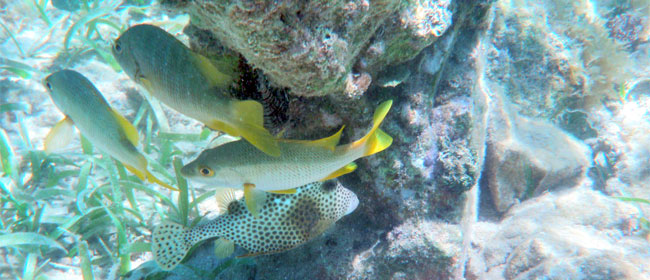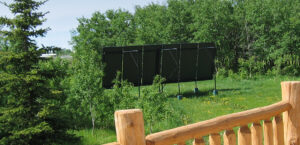I live in Calgary, AB, Canada. An area landlocked by mountains on one side and prairie on the other. I have a love of water so when I get a chance to holiday then it is usually somewhere near the ocean.
Last March, Mark and I took a trip to Roatan, an island off the coast of Honduras. We stayed in an ECO Lodge named Tranquil Seas and it was my favourite all time place to stay. It wasn’t only the lush gardens, friendly environment or comfortable cabana that made this place great, it included an ECO attitude that we like and admired.
Tranquil Seas featured an incredibly diverse snorkelling spot, off their dock and just 20 feet from the shore. This consisted of sunken concrete forms that gave fish and underwater creatures shelter and protection from predators. When setting us up for snorkelling Chris, the resorts’ hard working owner, made sure to tell us that the only thing we should touch in the ocean was our cameras and to refrain from standing on any coral or rocks (especially on the nearby reef). Do not disturb the ecosystem.
Once I got in the water it was really hard to leave. It is in exploring places like this that I have come to value the oceans and wild places in our world. I am not a diver but I love to snorkel. It is so amazing to be able to see fish and other marine animals in their natural environment.
I saw a variety of marine life, even a small octopus. Unfortunately I also saw a Lionfish, a major sea predator that has been introduced to the Caribbean when Hurricane Andrew destroyed a private aquarium, allowing a handful of these poisonous predators to escape: Lionfish devastate Florida’s Native Shoal. These predators have voracious appetites, and devour many times their weight in fish, they have no natural enemy’s in this new habitat, and they bear 20,000 to 30,000 eggs every four days.
Local divers are encouraged to spear these, taking care to not touch their long poisonous spines. We were able to taste a Lionfish and it is quite good. Hopefully, locals will take a liking to this fish which could help in a small way.
While we were staying at Tranquil Seas, we met Ein, a good friend of Chris, who spends his working days examining the health of the reef. Ein told us that the local reef was not as healthy as it should be and there are several dangers to the reef ecosystem.
We were given a publication from HealthyReefs.org that states that 47% of 326 sampled reefs were in poor condition, 6% critical.
There is hope for 42% of the remaining reef as conservation organizations work with local authorities to help them understand the value and financial viability of these areas. I have taken the following Danger from The Report Card on Mesoamerican Reef, a publication available from the organization.
Dangers to the reef include:
- Coastal Development and dredging (causing nutrient, sediment and other pollution; and loss of nursery habitat including mangroves and seagrass)
- Inland clearing and agriculture (increasing pollution from agrochemicals, sediments, and nutrients, and decreasing natural riparian buffers)
- Lionfish have become a problematic invasive species in the Caribbean, first reported in the Mesoamerican in 2008. They are not native to the area and have no known predators
- Overfishing (reducing fish populations and disrupting food webs)
- Natural Disasters such as Hurricanes and Storms cause breakage and removal of corals
- Rising water temperatures increase coral bleaching and diseases as well as mortality
- Offshore drilling dangers such as the recent BP disaster – no active offshore drillings are going on in the local Mesoamerican reef at this time, although there are some offshore concessions for exploration.
It was hard to see the dangers as I spent my days off the dock in my small ocean ecosystem. But we were made to understand the importance and the vulnerabilities of the local reef, an important action step taken by the local population. There are several other steps recommended and being taken. There is hope for the reef if we all work together to protect, participate and communicate. I only hope that the next time I visit Tranquil Seas that the reef and this small area just off the dock remains just as diverse as it was during my stay.
For more information on protecting our oceans you can consider Ted Danson’s book: Oceana, Our Endangered Oceans and What We Can Do to Save Them. You can also explore the Oceana.org.










Thank you, I have recently been searching for information about this topic for ages and yours is the best I have discovered so far.
As a scuba diver this is a cause close to my heart and I love Roatan, I did my first shark dive there. A lot of popular reefs are in danger since despite all the warnings people still touch the reefs, either on purpose or by accident if they don’t have good buoyancy, but unfortunately the result is the same either way for the reef. Thanks for bringing attention to something that everybody can do to make a difference.